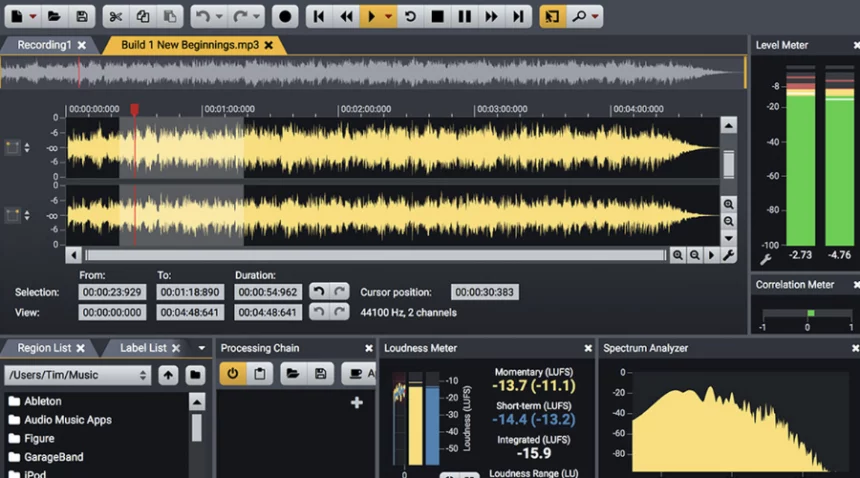Are you looking to explore the power of audio software? From producing music to creating sound effects for videos, audio software is becoming increasingly popular for amateur and professional audio engineers alike. With the right knowledge, you can unlock the power of these powerful tools and produce stunning results. In this comprehensive guide, we will cover the basics of audio software and explore how you can use it to create high-quality sound. From the basics of digital audio and audio processing to advanced production techniques, you will learn how to make the most of the software and create great audio content. With this guide, you will be well-equipped to create amazing audio content with your audio software.
Are you looking to explore the power of audio software? From producing music to creating sound effects for videos, audio software is becoming increasingly popular for amateur and professional audio engineers alike. With the right knowledge, you can unlock the power of these powerful tools and produce stunning results. In this comprehensive guide, we will cover the basics of audio software and explore how you can use it to create high-quality sound. From the basics of digital audio and audio processing to advanced production techniques, you will learn how to make the most of the software and create great audio content. With this guide, you will be well-equipped to create amazing audio content with your audio software.
Basics of Digital Audio and Audio Processing
In order to understand how audio software works, we must first understand the basics of digital audio and audio processing. Digital audio is a form of audio that is stored in computer memory as a series of numbers. These numbers represent the sound wave of the audio, allowing for the manipulation and alteration of the audio’s characteristics. Audio processing is the process of manipulating the sound wave, changing its pitch, tone, volume, and more. Audio software is a computer program that allows users to manipulate digital audio in various ways.
The most common type of audio software is a Digital Audio Workstation (DAW). A DAW is a type of software that allows users to record, edit, and mix audio. It consists of a number of different tools, including audio editors, synthesizers, and other audio production tools. In addition to DAWs, there are a variety of other types of audio software, including sample libraries, effects plugins, and mastering software.
The key to getting the most out of audio software is understanding the basics of digital audio and audio processing. It’s important to understand the different types of audio software and how they work, as well as the different types of audio files and how they are manipulated. With a basic understanding of these concepts, you will be able to get the most out of your audio software and create great audio content.
Software Options for Professionals and Amateurs
When it comes to audio software, there are a variety of options available to both professionals and amateurs. Professional audio software is typically more expensive and offers more features than amateur software. Professional software is also more complex and requires a greater level of knowledge in order to use it effectively.
For professionals, the most popular audio software is Pro Tools, which is a digital audio workstation developed by Avid Technology. Pro Tools is the industry standard for audio production and is used in recording studios, film and television studios, and post-production houses. Other popular professional audio software includes Logic Pro, Cubase, and Ableton Live.
For amateurs, there are a variety of free and inexpensive options that offer a range of features. Popular amateur audio software includes Audacity, FL Studio, and Reason. These programs are designed to be user-friendly and are great for beginners.
Tips for Choosing the Right Software
Choosing the right audio software for your needs can be a daunting task. There are a variety of factors to consider, including budget, features, and user experience. Here are some tips to help you select the right audio software for your needs.
First, consider your budget and the features you need. Professional software is typically more expensive and offers more features than amateur software. So if you’re on a tight budget, you may want to opt for amateur software. On the other hand, if you have a larger budget and need more features, professional software may be the best option.
Second, think about the type of audio content you will be creating. Different audio software is better suited for different types of audio content. For example, if you’re creating music, you may want to opt for a digital audio workstation like Pro Tools or Logic Pro. If you’re working with sound effects, you may want to opt for a program like Reason or Audacity.
Third, consider the user experience. Not all audio software is user-friendly, and some require a steep learning curve. If you’re a beginner, you may want to opt for audio software with an intuitive user interface.
Finally, research reviews and ratings of the software. Read user reviews to get an idea of what other people think of the software, and look for ratings from professional audio engineers. This will help you make an informed decision and ensure that you choose the right audio software for your needs.
Advanced Production Techniques with Audio Software
Once you’ve chosen the right audio software for your needs, you can begin to explore the advanced production techniques available. Here are some tips for taking your audio production to the next level with audio software.
First, explore the different types of effects plugins available. Effects plugins are tools that allow you to alter the sound of the audio in a variety of ways. For example, you can use an EQ plugin to adjust the frequency response of the audio, or a compressor plugin to control the dynamic range. By experimenting with different plugins, you can create unique and interesting sounds.
Second, take advantage of automation. Automation allows you to control the parameters of a track over time. For example, you can automate the volume of a track or the frequency response of an effect. This allows you to create dynamic and interesting sounds that would be impossible to achieve manually.
Third, explore the use of sidechaining. Sidechaining is a technique used to create a “pumping” effect in the audio. This is often used in dance music but can be used in any genre to create interesting effects.
Finally, experiment with sound synthesis. Synthesis is the process of creating sounds using oscillators, filters, and other tools. By experimenting with different synthesis techniques, you can create entirely new sounds that can be used in your audio projects.
Recording and Editing Audio with Audio Software
Recording and editing audios are the bread and butter of audio software. Here are some tips for recording and editing audio with audio software.
First, make sure you have the right hardware. Recording audio requires the right equipment, such as a microphone, preamp, and audio interface. If you don’t have the right hardware, you won’t be able to get the best sound quality.
Second, learn the basics of audio recording. Before you begin recording, it’s important to understand the basics of audio recordings, such as microphone placement, gain staging, and recording techniques.
Third, explore the editing tools available in your audio software. Most audio software includes a variety of editing tools, such as cut, copy, paste, and time stretching. By experimenting with these tools, you can manipulate the audio in a variety of ways.
Finally, don’t be afraid to experiment. Audio recording and editing can be a complex process, and it takes time to get the hang of it. Don’t be afraid to experiment and try out different techniques.
Mixing and Mastering with Audio Software
Mixing and mastering are two of the most important steps in the audio production process. Here are some tips for mixing and mastering with audio software.
First, learn the basics of mixing. Mixing is the process of combining multiple audio tracks into a cohesive whole. It involves balancing levels, adjusting panning, and adding effects.
Second, explore the different types of mixing tools available. Most audio software includes a variety of mixing tools, such as EQ, compression, and reverb. By experimenting with these tools, you can create a unique sound.
Third, understand the basics of mastering. Mastering is the final step in the audio production process. It is the process of creating a cohesive, balanced sound that is ready for distribution.
Fourth, take advantage of mastering plugins. Mastering plugins are tools that allow you to adjust the sound of the audio in a variety of ways. Popular mastering plugins include limiters, compressors, and EQs.
Automating and Automation with Audio Software
Automation is a powerful technique for creating dynamic, interesting sounds. Here are some tips for using automation with audio software.
First, understand the basics of automation. Automation is the process of controlling the parameters of a track over time. This can be used to create a variety of dynamic effects, such as volume swells and filter sweeps.
Second, explore the automation tools available in your audio software. Most audio software includes a variety of automation tools, such as envelope followers and LFOs. By experimenting with these tools, you can create unique and interesting sounds.
Third, use automation to create transitions. Automation can be used to create smooth transitions between sections. For example, you can use automation to fade out a track at the end of a song or to transition between sections of a track.
Fourth, use automation to create interesting effects. Automation can be used to create a variety of interesting effects. For example, you can use automation to create a delay effect or to create a tremolo effect.
Enhancing Audio with Audio Plugins
Audio plugins are tools that allow you to manipulate and enhance the sound of the audio in a variety of ways. Here are some tips for using audio plugins.
First, explore the different types of audio plugins available. There are a variety of audio plugins available, including EQs, compressors, reverbs, and delays. By experimenting with different plugins, you can find the sound you’re looking for.
Second, take advantage of plugin presets. Plugin presets are pre-made settings that can be used to quickly and easily alter the sound of the audio. Many audio plugins include a variety of presets, so you can get started quickly and easily.
Third, use plugins to enhance the sound of the audio. Plugins can be used to add depth and texture to the audio. For example, you can use a reverb plugin to add depth and space to the sound.
Fourth, use plugins to create unique sounds. Plugins can also be used to create entirely new sounds. For example, you can use a synthesizer plugin to create entirely new sounds that are not possible with traditional instruments.
Conclusion
Audio software is a powerful tool for creating high-quality audio content. With the right knowledge, you can unlock the power of these tools and create stunning results. In this comprehensive guide, we have covered the basics of digital audio and audio processing, explored software options for professionals and amateurs, discussed tips for choosing the right software, and explored advanced production techniques with audio software.
We have also discussed recording and editing audio with audio software, mixing and mastering with audio software, automating and automation with audio software, and enhancing audio with audio plugins. With this guide, you will be well-equipped to create amazing audio content with your audio software.



